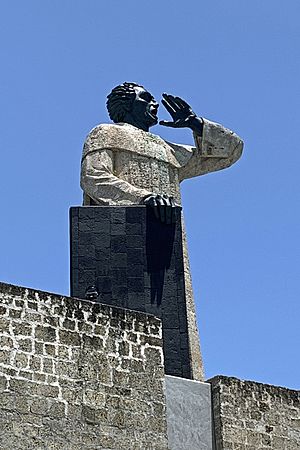Antonio de Montesinos facts for kids
Quick facts for kids Antonio de Montesino |
|
|---|---|

Sculpture by Antonio Castellanos Basich
|
|
| Native name | Antón de Montesino |
| Personal details | |
| Born | Salamanca, Spain |
| Died | 1545 New Granada |
| Nationality | Castillian |
| Denomination | Catholic |
| Motto | I am the voice of Christ in the desert of this island. |
Antonio de Montesinos (born around 1475 – died 1540) was a Spanish Dominican friar. He was a missionary on the island of Hispaniola. This island is now home to the Dominican Republic and Haiti.
Montesinos was the first European to speak out publicly. He bravely criticized the enslavement and harsh treatment of the native people on the island. His strong words started a long fight. This fight aimed to improve how the Spanish treated all native people in the New World. Montesinos' powerful message also inspired Bartolomé de las Casas. Las Casas later became a famous champion for the humane treatment of Indigenous peoples.
Contents
Early life
We do not know much about Montesinos' early life. He became a Dominican friar at a convent in Salamanca, Spain. He likely received his education there.
In September 1510, he joined the first group of Dominican missionaries. They traveled to Hispaniola. Pedro de Córdoba led this important group.
The Famous Sermon
On December 21, 1511, Montesinos gave a very powerful sermon. It was the fourth Sunday of Advent. He spoke against the Spanish encomienda system. This system allowed Spanish settlers to control native people and their land.
Montesinos strongly criticized the abuse of the Taíno Indians on Hispaniola. He listed many unfair things the Spanish colonists were doing. He said the Spanish on the island were "in mortal sin" because of their cruelty.
He also declared that he and other missionaries would not allow these slaveholders to confess their sins. Bartolomé de las Casas was there and heard the sermon. Montesinos asked the people listening:
Tell me by what right of justice do you hold these Indians in such a cruel and horrible servitude? On what authority have you waged such detestable wars against these people who dwelt quietly and peacefully on their own lands? Wars in which you have destroyed such an infinite number of them by homicides and slaughters never heard of before. Why do you keep them so oppressed and exhausted, without giving them enough to eat or curing them of the sicknesses they incur from the excessive labor you give them, and they die, or rather you kill them, in order to extract and acquire gold every day.
The sermon made the settlers and important citizens of Hispaniola very angry. This included the governor, Diego Columbus, who was Christopher Columbus's son. Montesinos' words had a huge impact on Las Casas. Las Casas later became famous for defending the rights of native peoples in the Americas.
The main goal of the Dominican friars in the New World was to help and represent the American Indians. They fought for their rights under Spanish and Portuguese rule for over 300 years.
Reactions to the Sermon
Because of the friars' protests in Santo Domingo, King Ferdinand II first ordered Montesinos and his supporters to return to Spain. The King initially called Montesinos' preaching "a new and baseless idea." He thought it was a "dangerous opinion" that would harm the land.
However, after returning to Spain, Montesinos and his supporters convinced the King. They showed him that their cause was right and fair.
As a result, the King created a special group. This group wrote the Laws of Burgos. These were the first laws designed to protect native people. The laws set rules for how to treat and convert native people. They also limited what the Spanish colonizers could demand from them.
Later Life and Travels
In July 1526, Montesinos joined Lucas Vásquez de Ayllón and 600 colonists. They started San Miguel de Gualdape. This was the first European settlement in what is now the United States. It was near Sapelo Sound in Georgia.
The colony lasted only about four months. Many people got sick or starved. The native population was also unfriendly. After Ayllón died in October 1526, the settlement was left empty. Montesinos and the other 150 survivors went back to Santo Domingo. It is believed that Montesinos and the other Dominicans were the first priests to celebrate Mass in the present-day United States.
When Montesinos returned to Hispaniola, he remained important in the region. In 1528, he traveled to Spain with Fray Tomás de Berlanga. They met with Charles V about important matters. While in Spain, Montesinos was named the protector of the Indians in the Province of Venezuela.
Charles V then gave the province to Ambrosio Alfinger and Bartolome Sayller. They represented the Welser banking family, who were German lenders to the emperor. Montesinos went with the German group to Venezuela in 1529. On June 27, 1540, Antonio de Montesinos tragically died. He was killed by an officer of the expedition because of his strong opposition to the exploitation of the Indians.
Legacy
There is a large statue of Montesinos giving his sermon in Santo Domingo. It stands on the seafront in the Dominican Republic. The stone and bronze statue is 15 meters (about 49 feet) tall. It was designed by Mexican sculptor Antonio Castellanos.
The Mexican government gave the statue to the Dominican people. It was dedicated in 1982 by the presidents of Mexico and the Dominican Republic.
See also
 In Spanish: Antonio de Montesinos para niños
In Spanish: Antonio de Montesinos para niños

